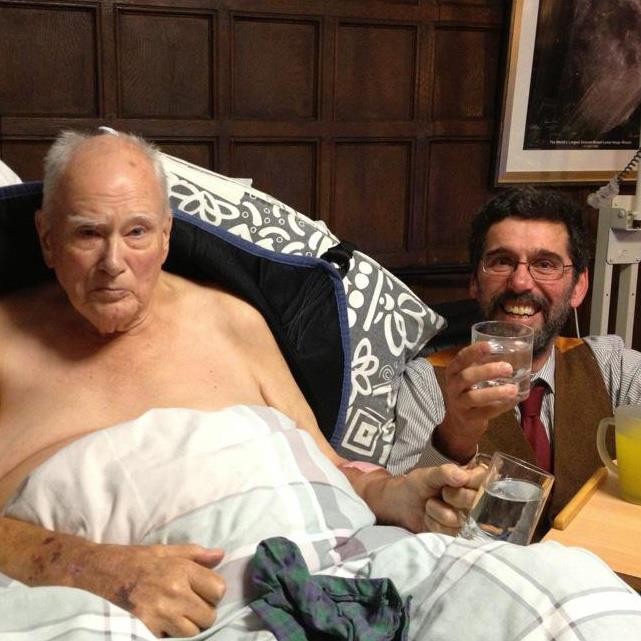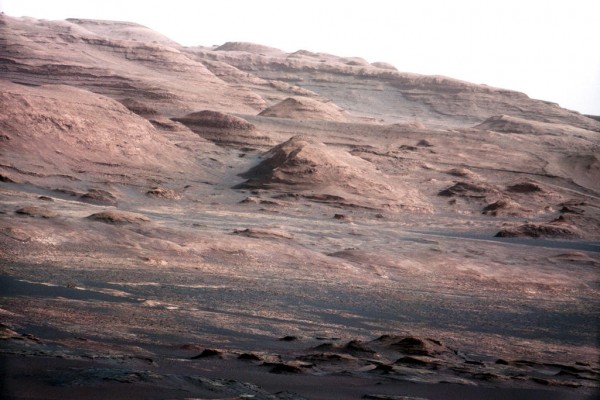By David Rothery
There’s a Patrick Moore-sized hole in the world of astronomy and planetary science that is unlikely ever to be exactly filled. He presented “The Sky at Night,” a monthly BBC TV astronomy programme, from 1957 until his death. This brought him celebrity, and the books that he wrote for the amateur enthusiast were bought or borrowed in vast numbers from public libraries for half a century — including by myself as a schoolboy. Patrick was the mainstay of the BBC’s Apollo Moon-landing coverage that those of us of a certain age will never forget, and there can be few amateur or professional astronomers who grew up in the UK without having been influenced by him. Tributes posted on the Internet show that he was known and admired beyond these shores too. They also attest to Patrick’s extraordinary generosity, exemplified by numerous accounts of how he replied to letters from strangers (of whom in the early 1970s I was one) or took time to chat after his lectures.
Patrick served with distinction and under age as a navigator with Bomber Command during the war. I believe (on the basis of dark hints made during late night conversations) that he also spent time on special operations in occupied Poland, where his youth and assumed Irish identity afforded him a plausible (but surely high-risk) cover story. An encounter with what he referred to as ‘a working concentration camp’ led to his lifelong professed dislike of Germans (“apart from Werner von Braun, the only good German I ever met”).
After the war, Patrick became a school teacher and also very active in the British Astronomical Association notably in its lunar section on account of his painstaking and careful observations of the Moon, some of which were to prove useful for both the American and Soviet lunar missions. He became a friend of the science fiction visionary Arthur C. Clarke, with whom he shared the authorship of Asteroid (2005) sold in aid of Sri Lankan tsunami relief.
I first met Patrick when we were speakers at a meeting to celebrate the 150th anniversary of the discovery of Neptune, so that must have been 1996. He spoke about Neptune itself, and I about its main satellite Triton. Afterwards he was kind enough to remark that he had read my book (Satellites of the Outer Planets). Our first joint TV appearance was “Live from Mars,” an Open University TV programme on a Saturday morning in 1997 when NASA’s Mars Pathfinder landed, allowing us to broadcast the first new pictures from the surface of Mars for nearly 20 years. I became an occasional guest on “The Sky at Night” more recently, which led to a friendship, as with so many of his guests. The programme was usually recorded at Patrick’s home in Selsey, and Patrick delighted to put his guests up overnight, rather than send them to a nearby hotel. That was a cue for an impressively-laden supper table, copious quantities of lubricant, and entertaining — if sometimes outrageous — conversation. Patrick had a wry sense of humour, and would self-parody his supposed extreme views. However, I think he was being serious when, or several occasions, he styled a certain recent US President as “a dangerous lunatic”.
I witnessed Patrick’s mobility decline from walking sticks, to zimmer frame, to wheelchair. His once famously rapid speech became slurry, but his mind and monocle-assisted eyesight stayed sharp. Co-presenters assumed larger and large roles on “The Sky at Night,” but Patrick was always there as the pivotal host. I last saw him less than three weeks before his death, when I guested on what was to prove his last “Sky at Night.” He was drowsy at first, but his intellect soon kicked in. He steered our discussion as ably as of old, and we were treated to a vintage Patrick moment of scepticism “When someone gives me a cupful of lunar water, then I’ll admit I was wrong.”
I lingered afterwards for a chat — inevitably partly about cats. Noticing the time, Patrick ordered a gin and tonic for each of us, and was soon involved in good-natured banter with his carer about why she would not let him have a second. He encouraged me to write a book about Mercury, and kindly agreed to write the foreword if I did. That’s an offer that I shall no longer be able to take him up on, but wherever you are, Patrick, I hope someone’s brought you that cupful of lunar water by now.
Sir Patrick Moore
4 March 1923 – 9 December 2012

Patrick Moore with David Rothery earlier this year.
David Rothery is a Senior Lecturer in Earth Sciences at the Open University UK, where he chairs a course on planetary science and the search for life. He is the author of Planets: A Very Short Introduction.
Image credit: Image is the personal property of David Rothery. Used with permission. Do not reproduce without explicit permission of David Rothery.
The post In memoriam: Patrick Moore appeared first on OUPblog.


By David Rothery
So Mars is ‘Place of the Year’! It has the biggest volcano in the Solar System — Olympus Mons — amazing dust storms, and the grandest canyon of all — Valles Marineris. Mind you, the surface area of Mars is almost the same as the total area of dry land on Earth, so to declare Mars as a whole to be ‘place of the year’ seems a little vague, given that previous winners (on Earth) have been islands or single countries. If you pushed me to specify a particular place on Mars most worthy of this accolade I would have to say Gale crater, the location chosen for NASA’s Curiosity Rover which landed with great success on 6 August.
This was chosen from a shortlist of several sites offering access to layers of martian sediment that had been deposited over a long time period, and thus expected to preserve evidence of how surface conditions have changed over billions of years. Gale crater is just over 150 km in diameter, but the relatively smooth patch within the crater where a landing could be safely attempted is only about 20 km across, and no previous Mars lander has been targeted with such high precision.

Perspective view of Gale crater. Curiosity landed in the ellipse within the nearest part of the crater. Image Credit: NASA
The thing that makes Gale one of the most special of Mars’s many craters is that its centre is occupied by a 5 km high mound, nicknamed Mount Sharp, made of eroded layers of sediment. To judge from its performance so far, the nuclear powered Curiosity Rover looks well capable of traversing the crater floor and then making its way up Mount Sharp layer by layer, reading Mars’s history as it goes. The topmost layers are probably rock made from wind-blown sand and dust. The oldest layers, occurring near the base of the central mound, will be the most interesting, because they appear to contain clay minerals of a kind that can form only in standing water. If that’s true, Curiosity will be able to dabble around in material that formed in ponds and lakes at a time when Mars was wetter and warmer than today. It will probably take a year or so to pick its way carefully across ten or so km of terrain to the exposures of the oldest, clay-bearing rocks, but already Curiosity has seen layers of pebbly rock that to a geologist are a sure sign that fast-flowing rivers or storm-fed flash-floods once crossed the crater floor.

Layers at the base of Mount Sharp that Curiosity will analyze. Image credit: NASA/JPL-Caltech/MSSS
The geologist in me wants to study the record of changing martian environments over time, because I like to find out what makes a planet tick. However the main reason why Mars continues to be the target for so many space missions, is that in the distant past — when those clay deposits were forming – its surface conditions could have been suitable for life to become established. Curiosity’s suite of sophisticated science instruments is designed to study rocks to determine whether they formed at a time when conditions were suitable for life. They won’t be able to prove that life existed, which will be a task for a future mission. If life ever did occur on Mars, then it might persist even today, if only in the form of simple microbes. Life probably will not be found at the surface, which today is cold, arid and exposed to ultraviolet light thanks to the thinness of its atmosphere, but within the soil or underneath rocks.
Finding life — whether still living or extinct — on another world would offer fundamental challenges to our view of our own place in the Universe. Currently we know of at least two other worlds in our Solar System where life could exist — Mars and Jupiter’s satellite Europa. It has also become clear that half the 400 billion stars in our Galaxy have their own planets. If conditions suitable for life occur on only a small fraction of those, that is still a vast number of potential habitats.
So, are we alone, or not? We don’t know how common it is for life to get started: some scientists think that it is inevitable, given the right conditions. Others regard it as an extremely rare event. If we were to find present or past life on Mars, then, provided we could rule out natural cross-contamination by local meteorites, this evidence of life starting twice in one Solar System would make it virtually unthinkable that it had not started among numerous planets of other stars too. Based on what we know today, Earth could be the only life-bearing planet in the Galaxy, but if we find independent life on Mars, then life, and probably intelligence, is surely abundant everywhere. As the visionary Arthur C. Clarke put it: “Two possibilities exist: Either we are alone in the Universe or we are not. Both are equally terrifying.” Terrifying or not, I’d like to know the answer. I don’t think Mars holds the key, but it surely holds one of the numbers of the combination-lock.
David Rothery is a Senior Lecturer in Earth Sciences at the Open University UK, where he chairs a course on planetary science and the search for life. He is the author of Planets: A Very Short Introduction. Read his previous blog post: “Is there life on Mars?”
The Very Short Introductions (VSI) series combines a small format with authoritative analysis and big ideas for hundreds of topic areas. Written by our expert authors, these books can change the way you think about the things that interest you and are the perfect introduction to subjects you previously knew nothing about. Grow your knowledge with OUPblog and the VSI series every Friday!
Oxford University Press’ annual Place of the Year, celebrating geographically interesting and inspiring places, coincides with its publication of Atlas of the World — the only atlas published annually — now in its 19th Edition. The Nineteenth Edition includes new census information, dozens of city maps, gorgeous satellite images of Earth, and a geographical glossary, once again offering exceptional value at a reasonable price. Read previous blog posts in our Place of the Year series.
Subscribe to the OUPblog via email or RSS.
Subscribe to only geography articles on the OUPblog via email or RSS.
The post Mars: A geologist’s perspective appeared first on OUPblog.







